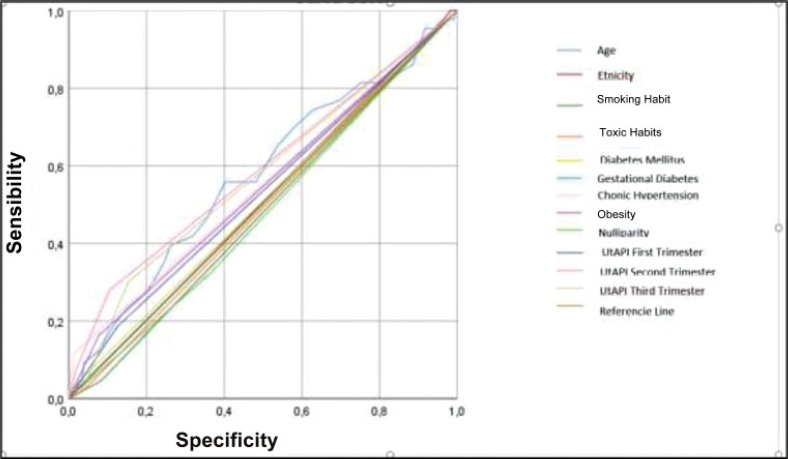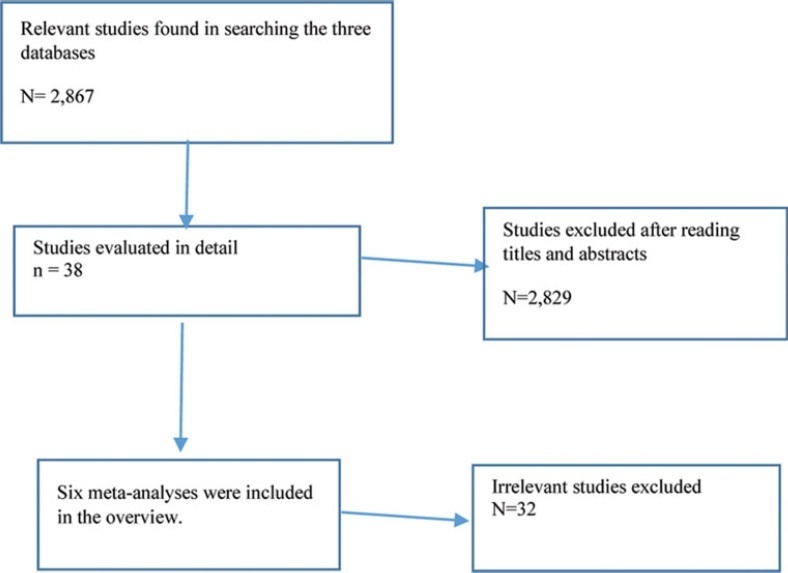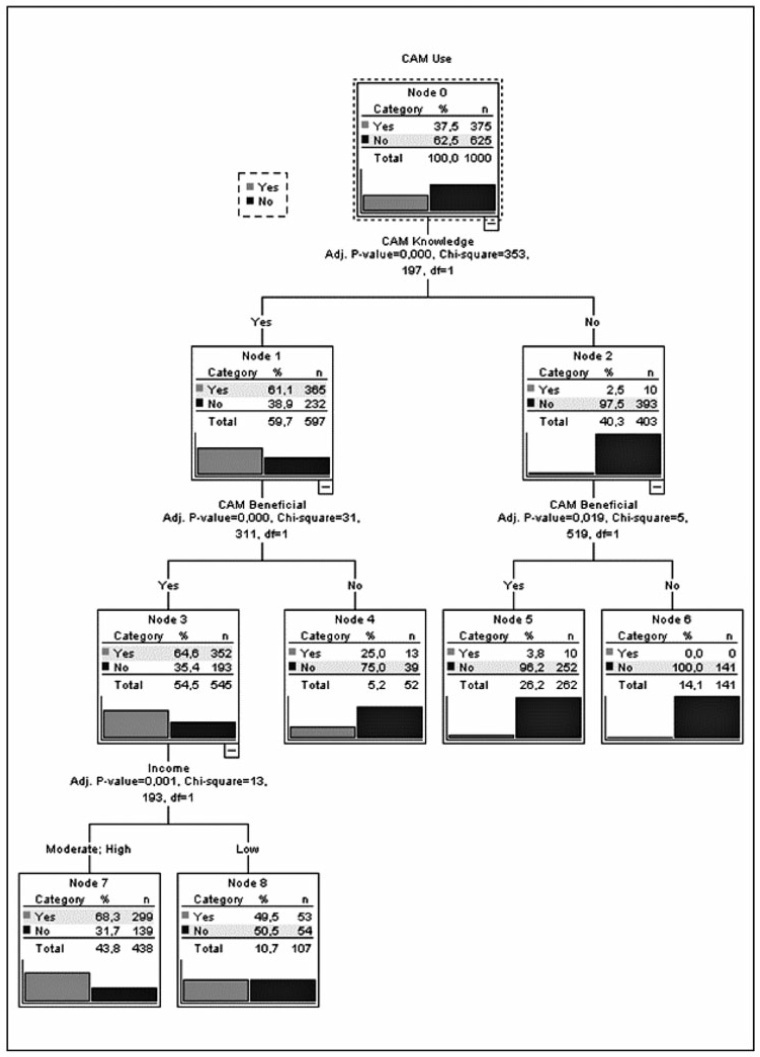-
Original Article
Uterine Artery Pulsatility Index as a Pre-eclampsia Predictor in the 3 Trimesters in Women with Singleton Pregnancies
Revista Brasileira de Ginecologia e Obstetrícia. 2021;43(12):904-910
01-24-2021
Summary
Original ArticleUterine Artery Pulsatility Index as a Pre-eclampsia Predictor in the 3 Trimesters in Women with Singleton Pregnancies
Revista Brasileira de Ginecologia e Obstetrícia. 2021;43(12):904-910
01-24-2021Views180See moreAbstract
Objective
To evaluate the mean uterine artery pulsatility index (UtAPI) in each trimester of pregnancy as a predictor of early or late pre-eclampsia (PE) in Colombian pregnant women.
Methods
The UtAPI was measured in singleton pregnancies in each trimester. Uterine artery pulsatility index as predictor of PE was evaluated by odds ratio (OR), receiver operating characteristic (ROC) curves, and Kaplan-Meier diagram.
Results
Analysis in the 1st and 3rd trimester showed that abnormal UtAPI was associated with early PE (OR: 5.99: 95% confidence interval [CI]: 1.64–21.13; and OR: 10.32; 95%CI: 2.75–42.49, respectively). Sensitivity and specificity were 71.4 and 79.6%, respectively, for developing PE (area under the curve [AUC]: 0.922). The Kaplan-Meier curve showed that a UtAPI of 0.76 (95%CI: 0.58–1.0) in the 1st trimester was associated with early PE, and a UtAPI of 0.73 (95%CI: 0.55–0.97) in the 3rd trimester was associated with late PE.
Conclusion
Uterine arteries proved to be a useful predictor tool in the 1st and 3rd trimesters for early PE and in the 3rd trimester for late PE in a pregnant population with high prevalence of PE.

-
Original Article
Diagnosing Septate Uterus Using Three-Dimensional Ultrasound Using Three Different Classifications: An Interobserver and Intraobserver Agreement Study
Revista Brasileira de Ginecologia e Obstetrícia. 2021;43(12):911-918
01-24-2021
Summary
Original ArticleDiagnosing Septate Uterus Using Three-Dimensional Ultrasound Using Three Different Classifications: An Interobserver and Intraobserver Agreement Study
Revista Brasileira de Ginecologia e Obstetrícia. 2021;43(12):911-918
01-24-2021Views160See moreAbstract
Objective
Currently, there are up to three different classifications for diagnosing septate uterus. The interobserver agreement among them has been poorly assessed.
Methods
A total of 50 three-dimensional (3D) volumes of a nonconsecutive series of women with suspected uterine malformation were used. Two nonexpert examiners evaluated a single 3D volume of the uterus of each woman, blinded to each other. The following measurements were performed: indentation depth, indentation angle, uterine fundal wall thickness, external fundal indentation, and indentation-to-wall-thickness (I:WT) ratio. Each observer had to assign a diagnosis in each case, according to the three classification systems (ESHRE/ESGE, ASRM, and CUME). The interobserver agreement regarding the ESHRE/ESGE, ASRM, and CUME classifications was assessed using the Cohen weighted kappa index (k). Agreement regarding the three classifications (ASRM versus ESHRE/ESGE, ASRM versus CUME, ESHRE/ESGE versus CUME) was also assessed.
Results
The interobserver agreement between the 2 nonexpert examiners was good for the ESHRE/ESGE (k = 0.74; 95% confidence interval [CI]: 0.55–0.92) and very good for the ASRM and CUME classification systems (k = 0.95; 95%CI: 0.86–1.00; and k = 0.91; 95%CI: 0.79–1.00, respectively). Agreement between the ESHRE/ESGE and ASRM classifications was moderate for both examiners. Agreement between the ESHRE/ESGE and CUME classifications was moderate for examiner 1 and good for examiner 2. Agreement between the ASRM and CUME classifications was good for both examiners.
Conclusion
The three classifications have good (ESHRE/ESGE) or very good (ASRM and CUME) interobserver agreement. Agreement between the ASRM and CUME classifications was higher than that for the ESHRE/ESGE and ASRM and ESHRE/ESGE and CUME classifications.

-
Original Article
Overview of the Effect of Complementary Medicine on Treating or Mitigating the Risk of Endometriosis
Revista Brasileira de Ginecologia e Obstetrícia. 2021;43(12):919-925
01-24-2021
Summary
Original ArticleOverview of the Effect of Complementary Medicine on Treating or Mitigating the Risk of Endometriosis
Revista Brasileira de Ginecologia e Obstetrícia. 2021;43(12):919-925
01-24-2021Views131See moreAbstract
Objective
Endometriosis is a hormone-dependent chronic inflammatory disease with symptoms such as pelvic pain, which affect the physical, emotional, and social health of women in reproductive age. The current overview article aims to explore the effect of complementary medicine on the treatment or in mitigating the risk of endometriosis.
Methods
This is an overview article done in Iran. Two separate researchers systematically searched 3 databases (Medline, Scopus, and Cochrane Central Register Trials) until September 2020. The methodological quality of each study was assessed using the assessment of multiple systematic reviews (AMSTAR) tool.
Results
The results of two reviews suggested that physical activity, tobacco smoking, diet, coffee and caffeine intake had no effect on mitigating the risk of endometriosis or improving its treatment, but acupuncture successfully reduced pain and related marker (serum CA-125) levels.
Conclusion
As endometriosis is an annoying disease with many complications and is hard to diagnose and treat, related studies in complementary medicine can help patients with endometriosis. Based on the relevant literature review, among the complementary medicine available for the treatment or to mitigate the risk of endometriosis, only acupuncture seems to alleviate the pain of endometriosis.

-
Original Article
School-based HPV Vaccination: The Challenges in a Brazilian Initiative
Revista Brasileira de Ginecologia e Obstetrícia. 2021;43(12):926-931
01-24-2021
Summary
Original ArticleSchool-based HPV Vaccination: The Challenges in a Brazilian Initiative
Revista Brasileira de Ginecologia e Obstetrícia. 2021;43(12):926-931
01-24-2021Views218See moreAbstract
Objective
The present study assesses the implementation and the impact after 2 years of a school-based human papillomavirus (HPV) vaccination program in a Brazilian city.
Methods
A prospective study assessing the implementation of the program, offering quadrivalent HPV vaccine in two annual doses to girls and boys aged from 9 to 10 years old. The program was started in the city of Indaiatuba, state of São Paulo, Brazil, in 2018, and had authorization from the National Immunization Program. The number of HPV vaccine first doses applied and the coverage in 2018 was calculated and compared to the year 2017. There were described events that have influenced the results.
Results
The program invited 4,878 children through schools (87.1% of the target population), and 7.5% refused vaccination. Several concurrent events required or competed for health professionals of the vaccination teams. The coverage of the first dose (between 9 and 10 years old) was 16.1% in 2017 and increased to 50.5% in 2018 (p < 0.0001). The first dose in all ages increased 78% in 2018 compared with 2017 (6,636/3,733). Competing demands over the program continued in 2019, and the first dose coverage dropped (26.9%). For 2020, a municipal law instituted school-based vaccination and the creation of dedicated teams for vaccination, and these strategies are waiting to be tested.
Conclusion
School-based annual HPV vaccination in children between 9 and 10 years old was feasible and increased vaccination coverage, regardless of gender, although the program was vulnerable to competing events.

-
Original Article
Increased Risk for Maternal Anxiety during the COVID-19 Outbreak in Brazil among Pregnant Women without Comorbidities
Revista Brasileira de Ginecologia e Obstetrícia. 2021;43(12):932-939
01-24-2021
Summary
Original ArticleIncreased Risk for Maternal Anxiety during the COVID-19 Outbreak in Brazil among Pregnant Women without Comorbidities
Revista Brasileira de Ginecologia e Obstetrícia. 2021;43(12):932-939
01-24-2021Views138Abstract
Objective
To study maternal anxiety in pregnant women without comorbidities in the context of the COVID-19 outbreak in Brazil and to study maternal knowledge and concerns about the pandemic.
Methods
This is a secondary analysis from a national multicenter cross-sectional study performed in 10 cities, from June to August, 2020, in Brazil. Interviewed postpartum women, without medical or obstetrical comorbidities, were included in the present subanalysis. A structured questionnaire and the Beck Anxiety Inventory (BAI) were applied.
Results
Out of the 1,662 women, 763 (45.9%) met the criteria for the current analysis and 16.1% presented with moderate and 11.5% with severe maternal anxiety. Moderate or severe maternal anxiety was associated with high school education (odds ratio [OR]:1.58; 95% confidence interval [CI]:1.04–2.40). The protective factor was cohabiting with a partner (OR: 0.46; 95%CI: 0.29–0.73). There was a positive correlation between the total BAI score and receiving information about care in the pandemic (rpartial 0.15; p < 0.001); concern about vertical transmission of COVID-19 (rpartial 0.10; p = 0.01); receiving information about breastfeeding (rpartial 0.08; p = 0.03); concerns about prenatal care (rpartial 0.10; p = 0.01), and concerns about the baby contracting COVID-19 (rpartial 0.11; p = 0.004). The correlation was negative in the following aspects: self-confidence in protecting from COVID-19 (rpartial 0.08; p = 0.04), having learned (rpartial 0.09; p = 0.01) and self-confidence in breastfeeding (rpartial 0.22; p < 0.001) in the context of the pandemic.
Conclusion
The anxiety of pregnant women without medical or obstetrical comorbidities was associated to high school educational level and not living with a partner during the COVID-19 pandemic. Self-confidence in protecting against COVID-19 and knowledge about breastfeeding care during the pandemic reduced maternal anxiety.
Key-words Breastfeedingchildbirthcoronavirus disease 2019Maternal anxietypandemicPostpartumPregnancyQuestionnairesSee more -
Original Article
Use of androgens at different stages of life: reproductive period: Number 11 – December 2021
Revista Brasileira de Ginecologia e Obstetrícia. 2021;43(12):988-993
01-24-2021
Summary
Original ArticleUse of androgens at different stages of life: reproductive period: Number 11 – December 2021
Revista Brasileira de Ginecologia e Obstetrícia. 2021;43(12):988-993
01-24-2021 -
Original Article
Complementary and Alternative Medicine Attitudes of Gynecologic Patients: Experience in a Tertiary Clinic
Revista Brasileira de Ginecologia e Obstetrícia. 2021;43(11):853-861
01-12-2021
Summary
Original ArticleComplementary and Alternative Medicine Attitudes of Gynecologic Patients: Experience in a Tertiary Clinic
Revista Brasileira de Ginecologia e Obstetrícia. 2021;43(11):853-861
01-12-2021Views116See moreAbstract
Objective
To evaluate the knowledge, attitudes, and behaviors regarding complementary and alternative medicine methods of patients who were admitted to gynecology outpatient clinics.
Methods
In the present survey, a questionnaire on complementary and alternative medicine practices was applied on 1,000 women (ages between 18 and 83 years old) who were admitted to the gynecology outpatient clinic of a tertiarymaternity hospital. Demographic features and knowledge, attitudes, and behaviors about these methods were inquired in face-to-face interviews.
Results
While 80.7% of the total participants thought that complementary and alternative medicine was beneficial, only 37.5% of them had used these methods previously. The rate of prior knowledge on this subject was of 59.7% and the source of information was physicians for 8.5% of the patients. However, 72.4% of all participants wanted to obtain information on these methods and 93.7% wanted to be informed by physicians. In the decision tree model, having knowledge about complementary and alternative medicine was the most effective factor determining its use (p<0.001). Phytotherapy was found to be the most used method, with 91.4%. The most preferred plant was onion (18.9%), and the most common reasons for herbal use were stress (15.4%) and fatigue (15.2%).
Conclusion
More than one-third of the patients who applied to the gynecology outpatient clinics used one of the complementary and alternativemedicine methods at least once. As gynecologists and obstetricians, we need to be more knowledgeable about these methods to provide correct guidance to our patients for accessing accurate and effective information.

-
Original Article
Association Between PON1 (L55M and Q192R) Genetic Polymorphism and Recurrent Pregnancy Loss in North Indian Women Exposed to Pesticides
Revista Brasileira de Ginecologia e Obstetrícia. 2021;43(11):805-810
01-12-2021
Summary
Original ArticleAssociation Between PON1 (L55M and Q192R) Genetic Polymorphism and Recurrent Pregnancy Loss in North Indian Women Exposed to Pesticides
Revista Brasileira de Ginecologia e Obstetrícia. 2021;43(11):805-810
01-12-2021Views194See moreAbstract
Objective
The aim of the present study was to examine the relation between the PON1 polymorphisms and recurrent pregnancy loss (RPL).
Methods
In a cross-sectional study, blood samples were collected from 100 females. DNA was extracted and PON1 genotypes were determined by polymerase chain reaction (PCR) amplification.
Results
Regarding PON1 L55M, the mutated allele (M) frequency was found in 70.5% in RPL and in 53.5% in controls; theMallele was significantly associated with an increased risk of RPL (adjusted odds ratio [ORadj]=2.07; 95% confidence interval [CI]; p<0.001). However, regarding PON1 Q192R, the R mutated allele frequency was found in 28.5% in RPL and in 33% in controls. The R allele did not show any risk for RPL (ORadj 0.81; 95%CI; p=0.329).
Conclusion
The present study suggests that there is an effect of genetic polymorphism on RPL and provides additional evidence that combines with the growing information about the ways in which certain PON1 genotypes can affect the development of the fetus in the uterus.


